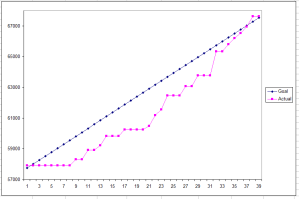(continued from part one, part two, part three, and part four)
This is the final part of my series, and it concerns the revision phase.
Once I knew I was going to finish the initial draft of my novel, I also knew there would be many more drafts to follow. It wasn’t just because everything I read about writing said this would happen. I knew it instinctively, because I know myself – perfectionistic, detail-oriented, I couldn’t rest with just one pass through. On the other hand, I also had to limit myself, because I knew I could probably keep going and going and drive myself crazy.
Thus, my plan had always been:
- Draft 1: The initial draft, get the story out on the screen and finish it
- Draft 2: Make the story cohesive, thematic, consistent; cut what no longer fits (think: 20 grit sandpaper)
- Draft 3: Polish the prose; read the story in one sitting to create a proper flow
- Beta reader phase: let friends and family read the whole thing and offer constructive criticism
- Final Draft: Incorporate suggestions I agree with from beta reader phase.
And that is pretty much just how it has happened. Draft 2 was very difficult for me. I had hoped to finish all the above in three months’ time. Here is how Draft 2 worked out over those 3 months:
Yep, failed again. I chickened out on stickk this time, so maybe that had a part to play in it. Since the first half of the book was so different from the second half, I had to reread carefully to make sure I got rid of the old thematic stuff and seeded with new thematic stuff as I went along. I also kept Stephen King’s suggestion in the back of my head: “2nd draft = 1st draft minus 10%”. In the end, draft 2 was exactly that.
But how did I do that? Well, it was my son. You see, today is his due date; we’re expecting him to be born any day now. And I wanted to get draft 3 done and in the hands of beta readers before he was born. Then that would give them all a month or so to read it, and I could spend time with my family. I finally had the motivation I needed for the last big push. January was the hardest, getting through 3/4 of the book in one month.
Success, draft 2 was complete, and it was 10% smaller. And yet it really wasn’t as hard as I thought it would be. Not trying to sound arrogant here, honestly, but the evidence is clear: I am capable of doing quite a lot when properly motivated. So I re-learned something about myself these last 16 months: with the pressure of a definitive goal I can do great things. (Let’s see if I can solidify that in my mind and finish the next book, start to finish, in half that time.)
The first weekend in February I printed all 350 pages and read the whole thing in one sitting with a red pen in hand. Took another 2 weeks to put those edits in, and it got smaller still. Draft 1 was 109,000 words, Draft 3 was 96,000. During the last week of February I formatted everything and sent it out to the beta readers before March 1. And that is where it stands now.
So there you have it, how I wrote a novel in 16 months. Hopefully you yourself will be able to read it soon. I’m really considering ebook self-publishing, despite the prestige a “real” published work could bring. The always controversial Joe Konrath has some pretty convincing advice about this, so I’ll have to see what my beta-readers think. However I publish – and I WILL PUBLISH – I’ll be sure to let you watch the journey right here.
I hope you don’t feel cheated now that you’ve reached the end of the series. After all, the series was called “How I Wrote a Novel”, not how I published one. But I’m just as interested in that part of the story as you are. Stick around and watch me do it.




